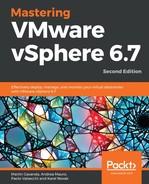Replication is usually part of the software stack of mid-range or high-range storage arrays. It allows you to replicate the data between two (or sometimes even more) physical storage arrays transparently. Replication is usually used for disaster recovery scenarios where you want to protect your infrastructure from complete site downtime.
There are two types of replication:
- Synchronous: When the ESXi server issues an SCSI command to the underlying storage, the data is first written to the primary storage, before being written to the secondary storage. Only once the secondary storage acknowledges that the data has been written is the acknowledgement sent to the VM. For synchronous replication, you need a high-performance storage area network because any delay caused by the interconnection between two storages will affect the overall latency of the VM. When the primary array fails, you do not lose any data because it is on both arrays simultaneously.
- Asynchronous: When the SCSI command is received, it is written to the primary storage, and an acknowledgement is immediately sent to the VM. Then, after a pre-defined replication interval, the data is synced to the secondary storage. If the primary storage fails, you will lose the data that has not yet been replicated to the secondary array.
